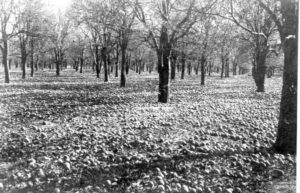Freezes. The one word nobody in the citrus industry wants to hear, yet freezes throughout the century have played a huge role in the history of Florida citrus.
The first orange groves were planted in St. Augustine around 1565. Severe freezes in 1835 and 1894 forced growers to head south, where Central Florida would become the hub of the citrus industry.
By 1980, Lake County boasted 122,777 acres of orange groves. Little did farmers know, the next decade would prove to forever change the scene of the citrus industry. Christmas morning of 1983, temperatures dipped to 20 degrees in most areas and 14 degrees in the colder areas. Despite the damage, most trees started flushing out in the spring. In 1984, growers spent millions of pruning trees and reviving groves. However, in January 1985 another arctic blast hit just as the trees were flushing out with new foliage. The result of this freeze left Lake County with roughly 25,000 acres of citrus.
A handful of hopefuls rallied and replanted which brought the acreage count back up to 35,000 in 1989. Later that year, the industry was dealt a final blow with another Christmas freeze. Although it wasn’t considered the worst, the verdict was in and citrus would never again play a major role in the local economy. In only 6 years Lake County saw a significant decline in production, jobs, and income.
| Category | 1983-84 | 1988-89 | 1989-90 |
| Acreage | 117,700 | 26,228 | 35,000 |
| Production | 35 million | 2.5 million | 5 million |
| Total Income | $265 million | $129.7 million | unavailable |
| Total Employed | 18,000 | unavailable | 7,500 |
| Total Growers | 6,000 | unavailable | 1,000 |
Source: Lake County Cooperative Extension Service, John Jackson. The Daily Commercial circa 1989.
Another challenge arose in 1984 when scientists found a new strain of canker that appeared in many nurseries. Feared as a crippling disease for citrus trees and eager to prevent the spread, the state ordered 10 million trees burned in ‘84. An additional 10 million were scheduled for burning over the next five years. Many growers who lost everything in the ‘83 freeze mourned their young crop due to the burning program.
While the decline of citrus is certainly heartbreaking, farmers have turned to other crops such as tomatoes, green beans, peaches, blueberries, and many others. However, there’s still nothing quite like the endless orange groves of the past that will always be remembered.
Photo 1: Fallen citrus in the Speer grove after the 1886 freeze. 1886. Black & white photoprint. State Archives of Florida, Florida Memory. Accessed 28 Jul. 2019.<https://www.floridamemory.com/items/show/26168>.
Photo 2: Damage to an orange grove because of cold – Bartow, Florida. 1894. Black & white photonegative. State Archives of Florida, Florida Memory. Accessed 28 Jul. 2019.<https://www.floridamemory.com/items/show/117876>.




